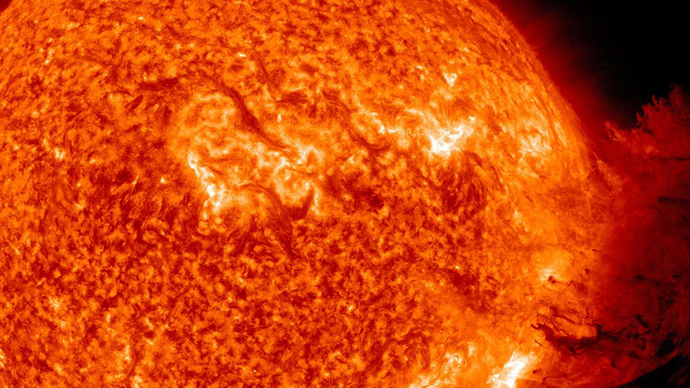
© Reuters/NASA
A spectacular mid-level solar flare was captured by NASA's Solar Dynamics Observatory, which released stunning footage of the looping whip of fire.
According to the North American Space Agency (NASA), the sun emitted the mid-level solar flare on Wednesday at 14:05 GMT. The flare was classified as an M6.5 example. M-class flares are ten times less powerful than the most intense X-class flares. Within a class there is a linear scale from 1 to 9.n (apart from X), so that an X2 flare is twice as powerful as an X1 flare, an M2 is twice as powerful as an M1, and so on.
The video captured by the observatory shows the flare "in a blend of two wavelengths of extreme ultraviolet light: 304 Angstroms and 171 Angstroms, colorized in yellow and red, respectively."
A solar flare is essentially a sudden brightening observed over the Sun's surface or apparent edge, known as the solar limb.
They usually occur when magnetic energy that has accumulated in the solar atmosphere, usually around sunspots, is suddenly released. There are massive magnetic loops called prominences on the surface of the sun. Each loop is so large, 15 Earth-sized planets could fit inside of them. When two prominences bump into each other, they essentially go haywire, setting off a series of explosions as powerful as millions of 100-megaton hydrogen bombs detonating simultaneously.
The flare ejects clouds of electrons, ions, and atoms through the corona - the halo of plasma surrounding the sun - into space. These clouds usually reach Earth a day or two after the event. The resulting electromagnetic radiation runs the entire gambit of the electromagnetic spectrum at all wavelengths, from long-wave radio to the shortest wavelength gamma rays.
While the energy sufficient for a solar flare might take hours or even days to build up, their energy is released within a matter of minutes.
Harmful radiation from a flare cannot pass through Earth's atmosphere to adversely affect living organisms, but still they can disrupt GPS and other communication signals when sufficiently intense.
Although some people worry that a gigantic "killer solar flare" could release enough energy to destroy Earth, NASA says this is not actually possible.
In fact, another phenomenon produced by the sun known as a coronal mass ejection or CME which could have a more adverse effect on Earth, the agency says.
CMEs - powerful eruptions on the sun's surface that send waves of magnetized plasma through the solar system - can buffet the earth's atmosphere with bursts of particles and can cause electromagnetic fluctuations.
Those fluctuations are capable of inducing electric fluctuations at ground level which can potentially blow out transformers in power grids. A CME's particles can also collide with crucial electronics onboard a satellite, disrupting its systems.
According to a report published in the Nature Communications journal last month, in 2012 a CME came
startlingly close to wreaking havoc on satellite systems and power grids around the planet.
Scientists believe that if the blasts had hit earth, the affects would have equaled the might of the most powerful magnetic storm ever recorded: the Carrington event of 1859, which saw a massive CME hit Earth's magnetosphere and take down telegraph services around the world.
A solar flare or coronal mass ejection hit induced the largest known solar storm, which was observed and recorded by Richard C. Carrington.
The Carrington event is theorized to have been well over X40, leading some scientists to believe that a Z class designation might be necessary.
Reader Comments
to our Newsletter